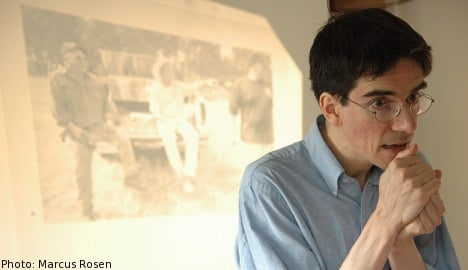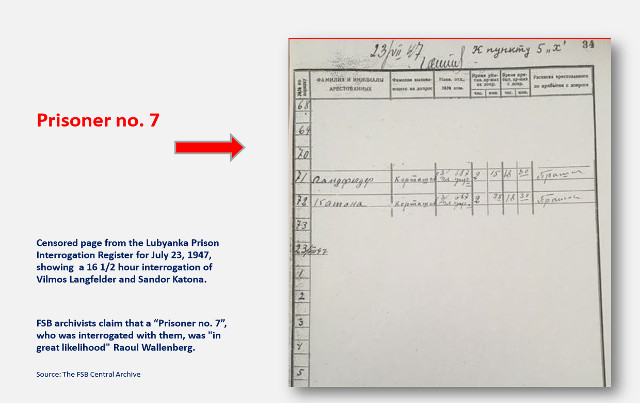The birthday of Swedish diplomat Raoul Wallenberg, missing since 1945, is celebrated worldwide and for a whole year his courage and deeds during WWII, rescuing tens of thousands of Jews from the holocaust, will be remembered.
Brian Palmer, a social anthropologist and a lecturer on civic courage at Uppsala University is one of many people finding a unique way of honouring Wallenberg’s legacy.
Together with author Ola Larsmo and Marie Grefberg, of the Forum for Living History (Forum för levande historia) in Sweden, Palmer has produced a calendar commemorating 365 people who’ve shown exceptional civic courage.
“We hope that the calendar will make people think about the meaning of civic courage and inspire people to ponder what’s worth doing and how we use our lives,” Palmer told The Local.
The calendar, which is for 2013, will be translated to English and South Korean, and about 130,000 copies will be given to Swedish high-school students, to be used as inspiration for their course-work.
Three publishing houses will print and sell a Swedish edition, an English-language edition, a South Korean edition, and an illustrated global edition in five languages, with profits going to human-rights endeavors.
On January 1st, national broadcaster Sveriges Radio/Radioteatern will start airing a five-minute piece about each day’s individual during every day of 2013. The Swedish film institute (Svenska Filminstitutet) will arrange film showings based on the calendar.
RELATED GALLERY: WHAT DO SWEDES KNOW OF RAOUL WALLENBERG?
The Local: What is the Raoul Wallenberg calendar?
Brian Palmer: We decided to make a calendar to honour Wallenberg but also other exceptionally courageous and self-sacrificing people who’ve shown themselves in moments of grace and goodness.
TL: Who is Raoul Wallenberg to you?
BP: He’s someone who found his calling in life and someone who used what was inside him, his bravery, his generosity and his cleverness. Wallenberg is also a reminder that what we do in a short period – only a few months in his case- can define our whole life.
TL: What is civic courage in one sentence?
BP: One can define civic courage as altruistic courage; a readiness to take risks to protect and help people outside of one’s own family and friends, or to protect a common ideal such as democracy.
TL: Do we have people like Wallenberg today?
BP: We do. There’s a tradition in Sweden of bravery and engagement in the international community with many courageous individuals trying to do something about the injustice in the world. For example, in the occupied territories of Palestine the largest number of international solidarity volunteers are often Swedish.
TL: What about the other 364 people in the calendar? Why are they important?
BP: We can take the example of Anastasia Baburova, a young Ukrainian journalist who wrote about right-wing extremist groups for Novaya Gazeta in Moscow.
She continued her work despite threats. Three years ago, after protesting against a Russian military man who had raped and killed a Chechen woman, Anastasia was shot dead, 25 years old. She seemed to believe that some things in life were even more important than her own safety and security.
The psychologist William James wrote a century ago that when we meet people who express altruistic courage we touch life’s ultimate mystery, why we exist and what it means to love other people. Anastasia raised these kinds of questions.
TL: This year is officially the “Wallenberg year” – why is this important?
BP: It’s about being reminded about the beauty of a human being who was ready to give so much to others. Reading accounts of Wallenberg; facing Nazis and taking gigantic risks to protect people – his life is a reminder that amidst our cruel world it’s possible for our species to shine this magnificently.
TL: Do you believe that Sweden has properly honoured the legacy of Raoul Wallenberg?
BP: Wallenberg remains a part of our tradition, and for me it would be appropriate if on airplanes landing in Stockholm one would hear the pilot say. “We’ll shortly be landing at the Raoul Wallenberg International Airport”. It would be a very clear marking to the international community that we honour one of our bravest countrymen.
The calendar will be sold in bookshops and supermarkets across Sweden as well as being available for purchase on the web.
To buy the English and South Korean pocket calendar, as well as the international wall calendar, links will be published here.
Salomon Rogberg




 Please whitelist us to continue reading.
Please whitelist us to continue reading.
Member comments